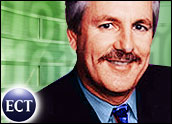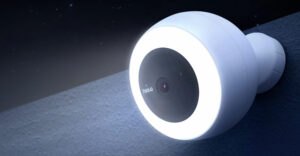
It was rather hard to find true convergence products at CES. Most vendors are still too enamored with technology and not excited enough about building a truly consumer-oriented, appliance-like offering. I wasn’t particularly excited about Apple’s announcements either, but I’ll leave that to another time and focus on the companies and products that stood out at CES.
Samsung: The New CE Power
The company that stood out as the real power at CES was Samsung. It had a huge booth located in the middle of the central hall containing a massive 102-inch flat-panel display that made everything else look small. Samsung sells the leading cell phones in Europe, a compelling PC printer line, a massive MP3 player line (including Gateway, a product in the iPod Mini class that also shows color pictures), a DVD line that includes a $130 portable player for kids, and a camera line that includes a small portable video camera with a remote that you can mount on your head or arm and tape sports events you’re participating in.
Samsung offers a line of notebook computers that appear more consistent than Sony’s and with a quality feel that appears to match the market leaders. The monitor line was impressive as well.
From the standpoint of showcasing products through the depth and breadth of its lines, Samsung served as the benchmark at CES. It made me realize that many of the technology vendors looking to enter this space simply don’t have the commitment to be successful in the long term. Just as in the automotive market, long-term success will go to those companies that have the most complete successful lines. The bit players will either exit or be acquired by the firms who can make the best use of economies of scale.
HP: Tech CE Leader
Of the tech companies one firm did stand out, and that was Hewlett-Packard. HP has the broadest lines of any of the tech firms, and it remains the most successful on the Microsoft Media Center platform. It is also the only vendor that resells the iPod — something that has both positive and negative aspects.
The outstanding product HP announced at the show is the Media Hub. Relying on an embedded version of Linux, it is the only product that approaches the TiVo standard for ease of use. Although the Hub lacks the interoperability advantages of the more robust Media Center line, HP should be able to address that shortcoming over time. The Hub was the closest thing to a blended product at CES and showed HP’s willingness to take a critical risk to make a market.
This product served as a big wake-up call for Microsoft, and that will benefit the entire segment greatly over time, prompting vendors to close the gap between what the market needs and what the market is getting.
What’s the Next iPod?
I’ve become convinced that the next iPod will fall into a different category altogether, and that it will either be a handheld gaming system or a cell phone with extended capabilities.
On the game side, the Sony PSP was the star of the show, with a recently announced US$150 price point. It allows users to play games, watch movies and listen to music, offering a better bargain than any of the Apple products, largely thanks to the subsidy that comes with gaming.
The hot phone was the Motorola V3 Razor, a sleek silver device that caught everyone’s attention. With a list price of over $600, it’s not cheap. It’s already on the market, and if you want one be prepared to pay a premium or wait a long time, as preorders have been fierce. What people forget about the original iPod is that it wasn’t cheap: It was a 100 percent offering, which is something that we rarely see in this market.
The V3 Razor is following in that tradition. The product is a tri-band world phone that plays short movies, takes pictures (with a zoom lens), plays games, supports the major e-mail standards, and is stunning to look at. Phones get subsidies too, and that subsidy can make a huge difference in the success of a product. Phones also have to deal with carriers, and I’m sure carriers will do their best to keep a phone from becoming the next iPod.
In my home the must-have product is a single remote control that can do everything, but these tend to be incredibly expensive and very difficult to program and maintain. If that weren’t bad enough, when you buy a new one you have to start all over again. Last year Logitech bought Harmony remote controls and overtook both Sony and Philips for the No. 1 spot in that industry. The company announced a new remote, the 880 Advanced, which arguably was one of the best converged products at the show. It allows you to use both your computer and the Web to keep it up to date, and it’s integrated with all of your CE equipment. And if your spouse loses it, you can take your saved settings off your computer and transfer them to the new one.
All of these products have significant demand potential if coupled with an iPod-like marketing program. Of course, only one company does iPod-like marketing these days.
TVs To Die For
CES was really about TVs. When you got away from that 102-inch screen, the really hot properties were the RCA Scenium DLP TV and the Sony Qualia 70-inch DLP TV. The RCA is the first wall-mountable DLP TV on the market, and it comes in 50-inch and 60-inch sizes. Priced around $10,000, it isn’t cheap, but it is a good value compared to the vastly more expensive and lower-performance plasma TVs you can get in those sizes.
You can’t mount the Sony on the wall, but the picture is stunning. At a whopping $13,000, it had better be. But that price might be considered a bargain, because this TV has the same engine as Sony’s $30,000 projector. If you live near a Sony store, take the time to go in and see this thing. It will at least give you a sense of what is possible, and, like me, you may have a hard time settling for less.
Enabling future TVs was a company called ViXS, which was showcasing a $100 solution that allows flat-panel vendors to send an HD signal — using 802.11a — from a tuner box to a flat panel display, thus avoiding the nightmare of installation and wiring. ViXS also enables the Sony Viao X, the only true media server from a major vendor. This will be a company to watch, as I expect reviewers — and buyers — will favor firms that deploy technology like this in their wall-mounted flat panels.
Microsoft SPOT Comes of Age
As some of you know, I’m enamored with my Tissot MSN Direct (SPOT). At CES Microsoft was showing a prototype product developed behind closed doors. This watch was like the Tissot but smaller and sleeker, with an upscale look and a number of improvements.
I think technology vendors need to do more of this kind of work to show the way for their partners to make better products. This was one of the only products at the show that was really forward-looking. Strangely enough, CES has become more of a showcase of products that are already on the market rather than of upcoming offerings. At least the Microsoft Spot team was fighting this trend. And though I didn’t see it, I heard that the automotive team was also showcasing a forward-looking offering.
2005 Convergence?
I’m still hoping to see a vendor combine the installation and appliance-like experience of the TiVo, the user interface of the Digeo Moxie, the infrastructure of the Microsoft Media Center, and the product range of Samsung. Next CES, assuming I recover from this one, we’ll see how much progress the industry has made.
Rob Enderle, a TechNewsWorld columnist, is the Principal Analyst for the Enderle Group, a consultancy that focuses on personal technology products and trends.






















































It’s funny how consistently wrong Enderle manages to be. About the iPod: So the next one will be a gaming device or phone? Sure.., when the very reason for the iPod’s popularity is its simplicity and focus. Turning it into a geeky gadget that does a million things – and none of them well – is the last thing Apple would do.